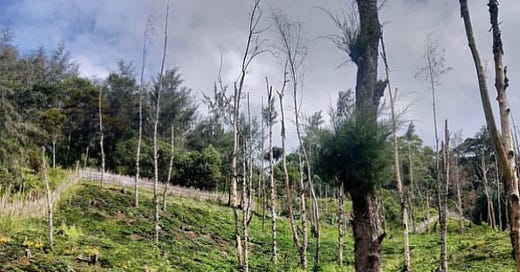In the remote and rugged highlands of Papua New Guinea, traditional indigenous communities have been practicing sustainable farming techniques for centuries. In fact the Kuk Valley in Jiwaka Province is the home of one of the first places on earth, where people started farming about 7000-6000 years ago.
Nestled among towering peaks and lush rainforests, these communities have learned to cultivate crops in harmony with the land, using methods that are both efficient and environmentally friendly. Methods passed down through the ages, infact these practices are still done today, if you go into any rural village where peoples lives revolve around farming, you will see this.
Rural peoples lives revolve around conversations of traditional practices: how to properly execute a method, how to mobilise resources, who will be available to help and if so how are we gonna feed the people who offered to help with what? It spans into a conversation that last for a couple of days depending on the magnitude of the task at hand and then materialises as a social debt for the recipient. There is no other entertainment or distraction from this world unless community customary obligations such as bride price, death etc. Everyone has to participate in this world, otherwise you will go hungry.
One such method is the "slash and burn" technique, where farmers clear small plots of land by cutting down and burning the vegetation. Young men usually relatives are mobilised, and given this task, “wok mak” which is basically shown where the ideal clearing should, food is cooked for them by the aunties and for the next couple of days are engaged in this. This creates fertile soil for planting, and also helps to control pests and disease. After a few years, the land is allowed to lay fallow and rejuvenate, before being cleared the grass/ wood it is burned here because the burning process releases nutrients which then fertilize the soil. So, the slash and burn process successfully clears land for agriculture and introduces fertilizing nutrients into the soil, leaving it in excellent condition to grow crops. This rotation system ensures that the land remains productive for generations to come.
Another technique used by these communities is terrace farming. This method involves building terraces on the sides of hills and mountains, which helps to prevent soil erosion and retain water for crops. The terraces also create a microclimate that is ideal for growing a variety of crops, such as sweet potatoes, yams, and coffee. This is more common as you approach higher altitudes.
The indigenous communities of Papua New Guinea also have a deep understanding of the plants and animals that inhabit the area, and they use this knowledge to create a diverse and sustainable food system. For instance, in their gardens they intercrop , that is plant complimentary crops as corn and sweet potatoes, or taros and greens and cucumber which maximise yield on a small piece of land.
Or they use they plant trees or plant which have herbal remedies to help with ailments such leaves of certain plants as a natural pest repellent. Another example is a thorny leaf traditionally known as salat to apply on sore muscles, and they also practice agroforestry, where they plant crops alongside trees that provide shade, protect the soil, and fix nitrogen in the soil. I also learnt the idea of drip irrigation, which is placing a stone next to a plant which somehow attracts moisture to the underneath of the rock and plant to feed the plant water.
Despite the challenges they face such as climate change and the loss of traditional knowledge, these communities are determined to continue their sustainable farming practices. Climate change has affected their planting and harvesting season, their work timetable as well as affecting the loss of traditional knowledge, that is slowly seeping away with time as people die of new illnesses such as malaria.
They are a shining example of how people can live in harmony with the land, and how traditional knowledge can be used to create a more sustainable future for all. Most of which costs them nothing but cooperation with other members of the extended family and community and utilisation of resources in the community.
As we strive to create a more sustainable world, we can learn much from the indigenous communities of Papua New Guinea, who have been living in harmony with nature for centuries. Their traditional farming methods provide a model for sustainable agriculture that can be adapted and applied all around the world.







Thanks Priscilla!
I already knew a little about this. However, I don’t think I had not previously heard of the use of a rock to attract moisture for a plant. I might try that during the next drought in eastern Australia.
I was also interested that you described malaria as something introduced recently. Sorry, I can’t remember whether those were the words you used. I previously had the impression that people in PNG have had to live with malaria for many generations. Is that not true in the highlands?
Diary Priscilla,
I worked in Enga for 2 years in the early 80's. I travelled all over usually on foot, going to remote areas such as the Hewa.Saw the agriculture first hand. Amazing. Went back 4 years ago, more or less the same with strawberries added - and goats. Saw my first overweight highlanders!